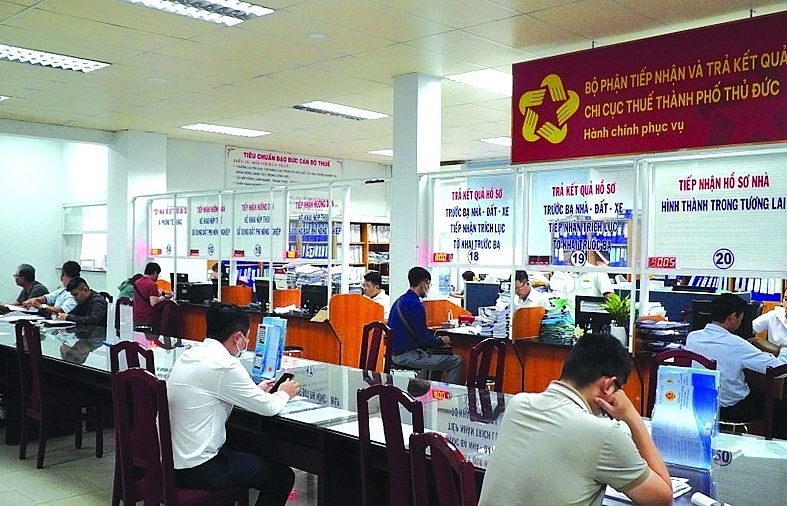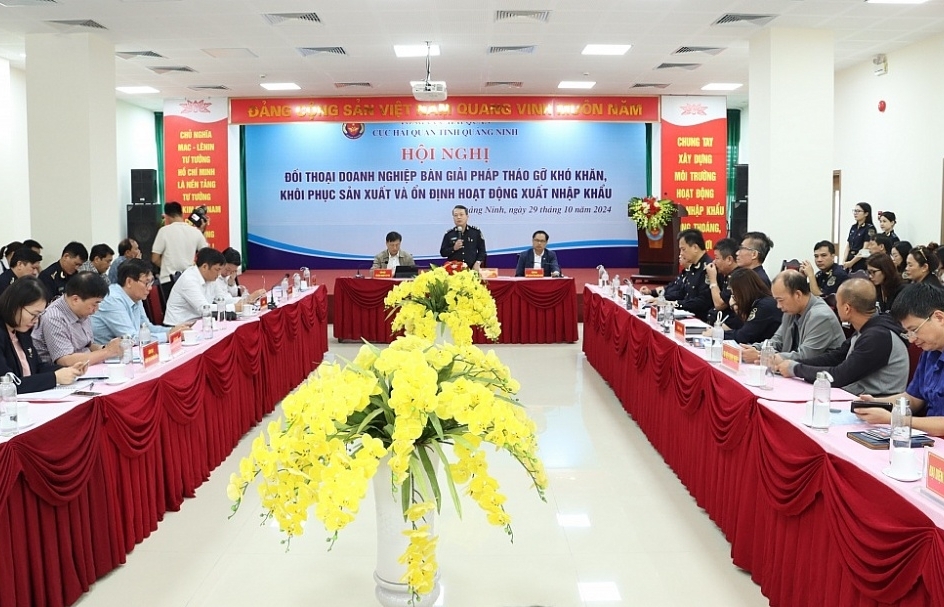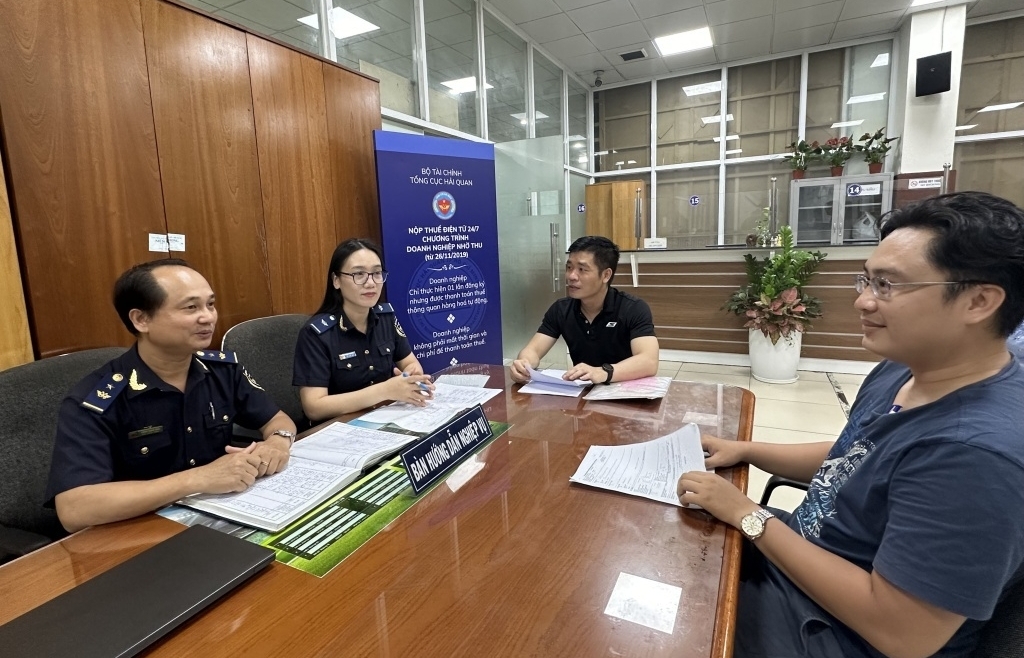Developing a new scheme to further support tax payer
| e-Tax payment 24/7: Upgrading to increase attraction | |
| The Tax sector: Gained significant revenues | |
| Expanding e-tax declaration to individuals with rental assets |
 |
| Customs operation at Mong Cai Customs Department, Quang Ninh Customs Department. Photo: T.Tr |
Over the past time, the administrative procedure reform and trade facilitation implemented by the Customs sector has come into reality, producing a unique level of efficiency for businesses in their import and export activities. In particular, the connection expansion with commercial banks allows for tax payment 24/7, strengthens the provision of online public service, reduces time and costs for businesses.
The 24/7 e-tax payment system supports businesses to be able to actively implement tax payment on any device, anytime, anywhere and not have to depend on working hours and going to a bank, the State Treasury and the Customs. Especially, this tax payment method will ensure the security of tax payers’ information during a transaction on the system, and removes the limitations on information field when exchanging one or more payment documents via inter-bank; removes shortcomings on the transaction time of commercial banks.
With the desire to further shorten the time for tax payment for businesses, the Import-Export Duty Department is building an additional scheme for automated tax collection after a business has authorized the collection to the Customs, to further support a business in Customs clearance.
Ms. Nguyen Thi Thanh Huong-Deputy Head of the Estimate and Budget Management Division, under the Import-Export Duty Department, said that this new scheme will allow a business to make a payment order via the Customs payment system to request a bank to deduct tax. Accordingly, the business does not have to directly make the payment order, it will authorize the Customs to automatically transmit debt status of the business to the bank that is authorized by the business to automatically deduct from their account to implement tax payment.
In order for the customs office to actively transmit the receivable amount from the business’s authorized bank account, the business must send a written request to the customs office to transmit the tax debt information to the authorized bank right after tax debts incur.
The processes are quite simple after the business notifies the Customs that it authorized the bank to automatically deduct from their account when receiving the Customs authority’s notification. The business owing a tax debt shall provide information on its account and information to the bank holding a debt deduction account (the same as the process for application for e-tax payment and Customs clearance 24/7); the business declares Customs declaration (with digital signature); the VNACCS will issue a document on the receivable amount, and update on the centralized accounting system to calculate the receivable amount for the business.
After the bank deducts the tax debt from the business’ account, and transmits to the e-tax payment portal, the process of the authorized bank and the Customs process is similar to the process of e-Customs payment. When the Customs authority receives the payment information sent by the authorized bank, if the information is appropriate, the bank will deduct the debt for the business. If the tax debt on the Customs declaration has been fully paid and Customs procedures have been completed, the tax accounting system will transmit the confirmation on the completed tax payment to the VNACCS system for Customs clearance. After receiving the credit statements from the State Treasury, the customs authority shall account the tax debt liquidity to the state budget.
The Import-Export Duty Department’s representative said that the requirement for the deployment of the new method is that a business must issue a written authorization to the bank for debt deduction from an account basing on the Customs’ notification when tax debts incur. At the same time, the business must issue a written request to Customs to send tax debt information to the authorized bank right after other tax debts and receivable amounts incur.
A mandatory requirement is that a business must use a digital signature (it can use digital signature declaring VNACCS declaration). However, in fact, a business implementing customs procedures can hire a customs broker. Therefore, if the Customs broker uses its digital signature to carry out Customs procedures, it must submit the business’ digital signature.
 | Ha Noi deploys month of accompanying with taxpayer VCN- According to the Ha Noi Tax Department, from 5th March 2018 to 5th April 2018, Ha Noi Tax ... |
If the business asks to use a new digital signature for payment, which is different from the digital signature declared on VNACCS, the Customs payment system needs to update the new business’ digital signature before sending tax debt information to the bank for deduction. The time the Customs system checks a digital signature is the time of checking digital signature on Customs declaration on VNACCS.
As for debit accounts, the representative of the Import and Export Duty Department said that the system automatically processes right after the business successfully declares on VNACCS, so in the system, one tax code can only correspond to one business account at an authorized bank for debt deduction. Therefore, if the business changes its account and the authorized bank, the business must notify the Customs authority to update the system before declaring Customs declaration on VNACCS.
Related News

Ensure harmony of interests of “3 parties” when applying 5% VAT on fertilizers
08:54 | 30/10/2024 Regulations

An Giang Customs announces businesses with tax arrears
14:51 | 24/10/2024 Anti-Smuggling

Tax, fee, and land rent exemption, reduction, and deferral policies: a driving force for business recovery and growth
11:34 | 27/10/2024 Regulations

Applying tax on animal feed ingredient faces problems due to specialized regulations
10:17 | 21/10/2024 Regulations
Latest News

Ha Nam Ninh Customs gathers feedback from the business community
09:55 | 04/11/2024 Customs

Facilitating trade and bolstering customs enforcement at Vinh Xuong border crossing
07:14 | 03/11/2024 Customs

3 items have a big impact on the budget revenue of Ho Chi Minh City Customs
19:38 | 02/11/2024 Customs

Quang Ninh Customs collects 85.75% of the budget revenue through the seaport area
19:37 | 02/11/2024 Customs
More News

Regulating goods across Huu Nghi International Border Gate during peak times
19:37 | 02/11/2024 Customs

Kien Giang Customs’ revenue reaches over 190% of target
10:36 | 02/11/2024 Customs

Quang Ninh Customs seeks solutions to promote import and export
10:34 | 02/11/2024 Customs

Businesses get a fair hearing under Customs' new 'three no' rule
09:31 | 31/10/2024 Customs

Khanh Hoa Customs reaches revenue target 1 quarter early
09:29 | 31/10/2024 Customs

WCO Permanent Technical Committee Meeting in Belgium: The managerial mark of the Vietnamese customs representative
09:29 | 31/10/2024 Customs

Revise regulations on implementing administrative procedures under the National Single Window
09:28 | 31/10/2024 Customs

Launch of the “Proud of 80 years of construction and development of Vietnam Customs” contest
09:08 | 30/10/2024 Customs

Cat Lai Port sees over 1,000 export shipments cleared by customs each day
08:56 | 30/10/2024 Customs
Your care

Ha Nam Ninh Customs gathers feedback from the business community
09:55 | 04/11/2024 Customs

Facilitating trade and bolstering customs enforcement at Vinh Xuong border crossing
07:14 | 03/11/2024 Customs

3 items have a big impact on the budget revenue of Ho Chi Minh City Customs
19:38 | 02/11/2024 Customs

Quang Ninh Customs collects 85.75% of the budget revenue through the seaport area
19:37 | 02/11/2024 Customs

Regulating goods across Huu Nghi International Border Gate during peak times
19:37 | 02/11/2024 Customs




